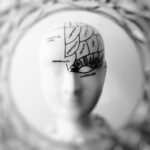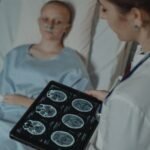John Doe, a 42-year-old male, was brought to the emergency department with a sudden and severe headache that he described as the “worst headache of his life.” He also complained of nausea, vomiting, photophobia (sensitivity to light), and a stiff neck. He reported experiencing the headache for approximately 1 hour before seeking medical attention. John Doe’s clinical evaluation and diagnosis underlined a typical presentation of a ruptured cerebral aneurysm, a medical emergency requiring prompt diagnosis and intervention to prevent further complications. So, what is a cerebral aneurysm?
A cerebral aneurysm, also known as a brain or intracranial aneurysm, is a potentially life-threatening medical condition characterized by the ballooning or bulging a weakened area in an artery within the brain. Looking for information on Brain aneurysms? This guide covers the symptoms and diagnosis, providing valuable insights for patients and caregivers.
Table of Contents
What is a Brain aneurysm?
Neurological disorders
- How Cerebral Hypoxia can lead to brain damage?

- Bipolar Disorder

- Mononeuropathy

- Poliomyelitis

- Neurodegenerative disorders

- Huntington’s disease (HD)

- Cerebral edema

- Migraine

- Brain Hemorrhage

- Epilepsy

- Polyneuropathy

- Encephalitis

- Increased Intracranial Pressure

- Types of Brain Tumors You Should Know About

- Brain Stroke: Symptoms, Diagnosis and Treatment

A brain aneurysm, also known as a cerebral or intracranial aneurysm, is a potentially life-threatening medical condition characterized by the ballooning or bulging a weakened area in an artery within the brain. These fragile outpouchings can be likened to a bubble on a tire. If ruptured, they can cause a sudden and severe brain haemorrhage, often leading to disability or death. Understanding brain aneurysms, their risk factors, symptoms, diagnosis, and treatment is crucial for early intervention and prevention.
Symptoms of Brain aneurysms
Brain aneurysm symptoms can be subtle or absent until a rupture occurs. When they manifest, common signs include a sudden, severe headache, often described as the “worst headache of one’s life.”
Other symptoms may include nausea, vomiting, blurred or double vision, photophobia ( sensitivity to light), and a stiff neck. Severe cases of a ruptured aneurysm can lead to loss of consciousness, neurological deficits, and even coma. However, it’s essential to note that many brain aneurysms remain asymptomatic until rupture, making early detection and preventive measures critical for at-risk individuals.
Who is more likely to get Brain aneurysms?
Brain aneurysms can develop due to a combination of genetic and environmental factors. While the exact cause is not always clear, several risk factors have been identified:
Causes and Risk Factors
- Family History of brain aneurysms increases an individual’s risk, suggesting a genetic predisposition.
- Hypertension can weaken the arterial walls and make aneurysms more likely to form or rupture.
- Smoking is a significant risk factor for aneurysm development and rupture, as it can damage blood vessels and increase blood pressure.
- Age and Gender: Aneurysms are more common in individuals over 40, and women are at a slightly higher risk than men.
- Certain Medical Conditions like polycystic kidney disease and some genetic disorders, such as Ehlers-Danlos syndrome and Marfan syndrome, are associated with an increased risk of aneurysms.
How is a Brain aneurysm diagnosed?
Brain aneurysms are typically diagnosed using medical imaging. Common diagnostic methods include:
- Cerebral Angiography: This is an invasive procedure where a contrast dye is injected into the arteries, allowing detailed X-ray images to identify aneurysms.
- CT Angiography: A less invasive alternative, CT angiography uses a special CT scanner and contrast dye to create 3D images of the blood vessels.
- Magnetic Resonance Angiography (MRA): MRA employs magnetic resonance imaging (MRI) to visualize the blood vessels, including aneurysms.
Diagnosis of Neurological Disorders
How is a Brain aneurysm treated?
Neurologists in Mumbai
- Dr. Deepak Solanki- Neuroanaesthetist at Artemis Hospitals, Gurugram

- Dr. Prashant Goyal- Psychiatrist at Balaji Action Medical Institute, Delhi
- Dr. Amit Kumar Shridhar- Spine Surgeon at Balaji Action Medical Institute, Delhi
- Dr. Ashwin Garg- Neuro Radiologist at Balaji Action Medical Institute, Delhi
- DR. TARUN MATHUR- Neurologist and Interventional Neurologist at Paras Hospital, Udaipur

- Dr. Pallavi Joshi- Clinical Psychologist at Balaji Action Medical Institute, Delhi
- Dr. Prachi- Clinical Psychologist at Balaji Action Medical Institute, Delhi
- DR. ANURAG LAMBA- Neurologist at Paras Hospital, Panchkula

- Dr. Aniruddh K Purohit – Neuro and Spine Surgeon at Aster Prime Hyderabad

- Ms. Archana Sharma- Clinical Psychologist at Balaji Action Medical Institute, Delhi

- Dr. Vishnu Gupta- Neuro Surgeon at Fortis Hospital, Punjab

- Dr. Vivek Vaid- Neuro Surgeon at Fortis Hospital, Jaipur

- Dr. Utkarsh Bhagat – Neuro Surgeon at Fortis Hospital, Haryana

- Dr. Sweety Trivedi- Neurologist at Fortis Hospital, Noida

- DR. SWETA SINGLA- Neurologist at Venkateshwara Hospital, Delhi

- Dr. Sumit Singh – Neurologist at Artemis Hospitals, Gurugram

- Dr. Soundappan V- Neuro and Spine Surgeon at Fortis Hospital, Chennai

- Dr. Sonal Gupta- Neuro Surgeon at Fortis Hospital, Delhi

- Dr. Shailaja Pokhriyal- CLINICAL PSYCHOLOGIST at BLK Hospital, Delhi

- Dr. Shanti Shankar Praharaj- Neuro and Spine Surgeon at Fortis Hospital, Karnataka

- Dr. Satish Satyanarayana- Neuro and Spine Surgeon at Fortis Hospital, Karnataka

- Dr. Sandhya Koche- Neurologist at Balaji Action Medical Institute, Delhi

- Dr. S Rajesh Reddy – Neuro Surgeon In Hyderabad

- Dr. SANDEEP VAISHYA- Neuro Surgeon at Fortis Hospital, Haryana

- Dr. Rohit Gupta- Neurologist at Fortis Hospital, Haryana

Managing a brain aneurysm depends on its size, location, and the patient’s overall health. Treatment options include:
- Observation: Small, unruptured aneurysms may be monitored closely with regular imaging to check for changes.
- Endovascular Coiling: This minimally invasive procedure involves placing a coil or coils within the aneurysm to block blood flow and prevent rupture.
- Surgical Clipping: In open surgery, a neurosurgeon places a small metal clip at the base of the aneurysm to prevent blood from entering it.
- Flow Diversion: A relatively new technique, flow diversion involves placing a stent-like device across the aneurysm’s neck to redirect blood flow away from the aneurysm and promote healing.
Treatment choice depends on factors like the aneurysm’s size, location, the patient’s age, and overall health. A team often decides medical professionals, including neurosurgeons and interventional neuroradiologists.
Prevention of Brain aneurysm
While some risk factors for brain aneurysms are beyond one’s control, there are steps individuals can take to reduce their risk:
- Controlling blood pressure through a healthy lifestyle and medication can help prevent aneurysms.
- Smoking cessation reduces the risk of aneurysm formation and rupture.
- A well-balanced diet and regular physical activity contribute to overall vascular health.
- Excessive alcohol intake can raise blood pressure and should be moderated.
- If there’s a family history of aneurysms or if any concerning symptoms are experienced, consult a healthcare provider for an evaluation.
Conclusion
- Brain aneurysms are severe medical conditions that can have devastating consequences when they rupture.
- Early diagnosis and prompt treatment are crucial for preventing ruptures and minimizing the associated risks.
- Understanding the risk factors, symptoms, and available treatment options is essential for individuals and their healthcare providers in managing this condition.
- A healthy lifestyle can also help reduce the risk of aneurysm development and rupture.





































